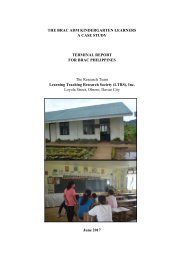terminal_report_final1
You also want an ePaper? Increase the reach of your titles
YUMPU automatically turns print PDFs into web optimized ePapers that Google loves.
P a g e | 18<br />
Voucher system of the Department of Education. Department Order No. 11,<br />
s. 2015 sets the policy guidelines on the implementation of the Senior High School<br />
(SHS) Voucher Program under the Government Assistance to Students and<br />
Teachers in Private Education (GASTPE) Program. The voucher program policy<br />
numbers 1 and 2 provides–<br />
1) The Enhanced Basic Education Act of 2013 (Republic Act No. 10533) provides for<br />
the expansion of the benefits and assistance programs under the Government<br />
Assistance to Students and Teachers in Private Education (Republic Act No. 8545)<br />
to qualified students under the Senior High School (SHS) Program, which is the<br />
additional two years of secondary education included in compulsory basic education<br />
beginning School Year (SY) 2016-2017.<br />
2) In relation to this, the Department of Education (DepEd) has developed the SHS<br />
Voucher Program, which provides qualified public and private Junior High School<br />
(JHS) completers with government subsidies which will enable them to enrol and<br />
study in non-DepEd schools licensed to offer the SHS Program.<br />
It goes to say that BIS wanting to establish a kinder and grade 1 classes as<br />
the initial stage of its birth cannot avail of this program from the government.<br />
Low salary of private school teachers, tenure and subsidy from the<br />
government. Nyamubi (2017) argued that when teachers feel positive about their<br />
income, especially their salaries, their accountability is boosted. Likewise, Jonathan,<br />
Darroux, and Thibeti (2013) opined that teachers’ job satisfaction would be<br />
improved if their welfare and workplace conditions such as streamlining salary<br />
structures and remuneration packages are fine-tuned in proportion with other<br />
professions. Moreover, Albee and Piveral (2003), maintained that appropriate salary<br />
levels foster commitment, thereby assuring that capable individuals continue to<br />
work in the school. Good salary is also necessary to recruit well-qualified teachers<br />
(Salami, 2008); whilst, poor salaries pushed teachers to embark on second jobs,<br />
mostly to the detriment of their school and students (Nguni, 2005).<br />
Boarini and Lüdemann (2009) utilized data on Programme for International<br />
Student Assessment (PISA) 2006 on student Science performance and OECD<br />
(Organisation for Economic Co-operation and Development) teacher salary data.<br />
They employed a multi-level analysis on the sample of OECD countries, and found<br />
that ‘teachers’ wages are associated with higher PISA performance’. Similarly,<br />
Woessmann (2011) combined country performance-pay measurements with PISA-<br />
2003 achievement data, and estimated international education production functions<br />
at the student level using alternative measures of the control variable for teacher<br />
salary levels. He found that ‘teacher performance pay is significantly positively<br />
related to achievement in Mathematics, Science, and Reading achievement between<br />
countries’. This goes to say that paying teachers good salary motivate them to<br />
deliver quality instruction to their students.




